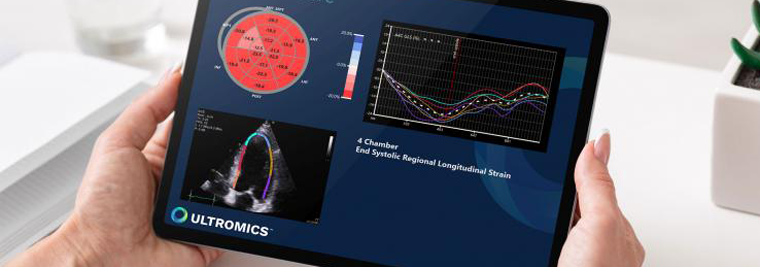Artificial Intelligence Predictors of Death from COVID-19
Find care now
If you are experiencing a medical emergency, please call 911 or seek care at an emergency room.

Researchers at MedStar Health led an international team that used artificial intelligence to evaluate cardiac images from patients across the globe who had COVID-19. Artificial intelligence derived heart measurements on echocardiograms were able to predict COVID-19 (SARS-CoV-2) mortality in an international cardiac ultrasound study of COVID-19 patients. The "Echocardiographic Correlates of in-hospital Death in Patients with Acute COVID-19 Infection: The World Alliance Societies of Echocardiography (WASE-COVID)" Study was presented at the American College of Cardiology (ACC) 2021 virtual Scientific Session.
This is an international, multi-center study conducted by the World Societies of Echocardiography to determine the clinical and echocardiographic phenotype of acute cardiac disease in COVID-19 patients, to explore phenotypic differences in different geographic regions across the world, and to identify parameters associated with in-hospital mortality. New research has revealed key insights into the varying international use of cardiac ultrasound on COVID-19 patients, and how artificial intelligence derived heart measurements were able to predict COVID-19 mortality. Federico Asch, M.D., director of the cardiovascular and echo core labs at MedStar Health Research Institute is the lead principal investigator.
This study looked at the crossover between COVID-19 and cardiac measurements among 870 patients from 13 medical centers in nine countries throughout Asia, Europe, United States, Latin America. Clinical and laboratory data were collected along with patient outcomes. The echocardiograms were analyzed with automated, machine learning-derived algorithms to calculate various data points.
The results showed significant regional differences in terms of patient co-morbidities, severity of illness, clinical biomarkers, and left ventricular and right ventricular echocardiographic metrics. In-hospital mortality rates varied by region, 11% in Asia, 19% in Europe, 27% in Latin America, and 26% in U.S.. Parameters associated with mortality were age, previous lung disease, left ventricular longitudinal strain, lactic dehydrogenase, and right ventricular free wall strain. The regional differences in cardiac phenotype highlight the significant differences in patient acuity as well as echocardiographic utilization in different parts of the world.
"Our original WASE Study first set out to see the state of healthy normal hearts across the world. It took us a few years to manually review all of that data," said Dr. Federico Asch, Director of the Cardiovascular and Echo Core Labs at MedStar Health Research Institute. "When the pandemic began, we knew that the clinical urgency to learn as much as possible about the cardiovascular connection to COVID-19 was incredibly high, and that we had to find a better way of securely and consistently reviewing all of this information in a timely manner."
Journal of the American Society of Echocardiography, DOI: 10.1016/j.echo.2021.05.010
This is an international, multi-center study conducted by the World Societies of Echocardiography to determine the clinical and echocardiographic phenotype of acute cardiac disease in COVID-19 patients, to explore phenotypic differences in different geographic regions across the world, and to identify parameters associated with in-hospital mortality. New research has revealed key insights into the varying international use of cardiac ultrasound on COVID-19 patients, and how artificial intelligence derived heart measurements were able to predict COVID-19 mortality. Federico Asch, M.D., director of the cardiovascular and echo core labs at MedStar Health Research Institute is the lead principal investigator.
This study looked at the crossover between COVID-19 and cardiac measurements among 870 patients from 13 medical centers in nine countries throughout Asia, Europe, United States, Latin America. Clinical and laboratory data were collected along with patient outcomes. The echocardiograms were analyzed with automated, machine learning-derived algorithms to calculate various data points.
The results showed significant regional differences in terms of patient co-morbidities, severity of illness, clinical biomarkers, and left ventricular and right ventricular echocardiographic metrics. In-hospital mortality rates varied by region, 11% in Asia, 19% in Europe, 27% in Latin America, and 26% in U.S.. Parameters associated with mortality were age, previous lung disease, left ventricular longitudinal strain, lactic dehydrogenase, and right ventricular free wall strain. The regional differences in cardiac phenotype highlight the significant differences in patient acuity as well as echocardiographic utilization in different parts of the world.
"Our original WASE Study first set out to see the state of healthy normal hearts across the world. It took us a few years to manually review all of that data," said Dr. Federico Asch, Director of the Cardiovascular and Echo Core Labs at MedStar Health Research Institute. "When the pandemic began, we knew that the clinical urgency to learn as much as possible about the cardiovascular connection to COVID-19 was incredibly high, and that we had to find a better way of securely and consistently reviewing all of this information in a timely manner."
Journal of the American Society of Echocardiography, DOI: 10.1016/j.echo.2021.05.010














